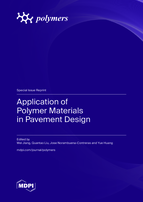Application of Polymer Materials in Pavement Design
A special issue of Polymers (ISSN 2073-4360). This special issue belongs to the section "Polymer Applications".
Deadline for manuscript submissions: closed (15 July 2023) | Viewed by 35675
Special Issue Editors
Interests: asphalt materials; eco-friendly road material; functional road materials; intelligent road materials
Special Issues, Collections and Topics in MDPI journals
Interests: pavement maintenance; asphalt concrete; self-healing; multi-cavity capsules
Special Issues, Collections and Topics in MDPI journals
Interests: construction materials; self-healing bituminous materials; waste valorisation
Special Issues, Collections and Topics in MDPI journals
Interests: life cycle assessment; pavement design and recycling; road safety
Special Issues, Collections and Topics in MDPI journals
Special Issue Information
Dear colleagues,
With the continuously growing demand for passenger transport and freight, the design, construction and maintenance of transportation infrastructure has faced with new development opportunities and challenges. Due to the effects of traffic load and environmental factors, the performance of road pavement will deteriorate. How to improve the performance and durability of road pavement is an important ongoing research question. In addition, the emerging technological and societal changes put forward a high demand for green pavement, environmentally friendly construction and maintenance, and smart and intelligent infrastructure. Traditional pavement materials cannot meet the needs of our evolving society. In recent years, the advantages of new materials in improving road performance have attracted extensive interest from industry and academia. Polymer materials have high thermal stability, superior mechanical properties, corrosion and chemical resistance. They are widely used in important fields of the economy such as aerospace, biomedicine, transportation, electronics, etc. With the development of material science and technology, polymer materials show great potential for application in the field of road.
SBS (styrene-butadiene-styrene), SBR (styrene-butadiene rubber), PE (polyethylene), EP (expanded polyethylene), PU (polyurethane), anti-rutting agent and other other synthetic and bio-based polymer materials can be used to modify asphalt and improve the performance of asphalt mix; As well, the application of polymer admixtures in cementitious materials (including cement and concrete) improves the hydration properties of cement and the strength and concrete durability. Polymer materials are also widely used in pavement maintenance and treatment, which can quickly restore road function and to extend the road service life. The application of functional polymer materials in the road pavement will not only meet the durability and stability requirements, but also achieve the requirements for green construction and lifecycle management of pavement, by reducing maintenance needs and volume of waste for disposal. The application of polymer materials in pavement design will fall within the scope of this Special Issue.
Prof. Dr. Wei Jiang
Prof. Dr. Quantao Liu
Prof. Dr. Jose Norambuena-Contreras
Prof. Dr. Yue Huang
Guest Editor
Manuscript Submission Information
Manuscripts should be submitted online at www.mdpi.com by registering and logging in to this website. Once you are registered, click here to go to the submission form. Manuscripts can be submitted until the deadline. All submissions that pass pre-check are peer-reviewed. Accepted papers will be published continuously in the journal (as soon as accepted) and will be listed together on the special issue website. Research articles, review articles as well as short communications are invited. For planned papers, a title and short abstract (about 100 words) can be sent to the Editorial Office for announcement on this website.
Submitted manuscripts should not have been published previously, nor be under consideration for publication elsewhere (except conference proceedings papers). All manuscripts are thoroughly refereed through a single-blind peer-review process. A guide for authors and other relevant information for submission of manuscripts is available on the Instructions for Authors page. Polymers is an international peer-reviewed open access semimonthly journal published by MDPI.
Please visit the Instructions for Authors page before submitting a manuscript. The Article Processing Charge (APC) for publication in this open access journal is 2700 CHF (Swiss Francs). Submitted papers should be well formatted and use good English. Authors may use MDPI's English editing service prior to publication or during author revisions.
Keywords
- asphalt pavement
- concrete pavement
- functional pavement
- environmentally friendly pavement
- pavement materials
- polymer materials
- bio-based polymers
- functional materials
- polymer-modified asphalt
- cement additive










